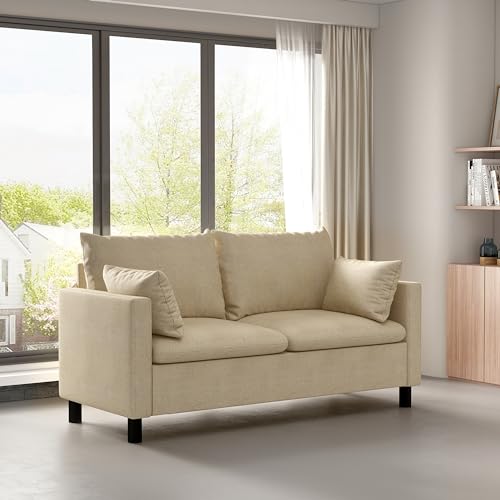Guide To 2 Seater Leather And Fabric Sofa: The Intermediate Guide On 2…
페이지 정보
작성자 Thalia Lemprier… 작성일 25-01-25 12:16 조회 8 댓글 0본문
 Choosing Between a 2 seater fabric lounge seater leather and fabric sofa (you could look here)
Choosing Between a 2 seater fabric lounge seater leather and fabric sofa (you could look here)If you're shopping for a new sofa it isn't easy to decide between fabric or leather. This is especially relevant if you're new to knowledge of furniture.
 If you have kids or live in a small apartment the leather option might be best for you. It's easy to wipe down and it looks fantastic in a lot of homes.
If you have kids or live in a small apartment the leather option might be best for you. It's easy to wipe down and it looks fantastic in a lot of homes.Comfort
The sofa is typically the focal point in most homes and is an important purchase. You want one that you can sit on for hours, looks great, fits with your room style and will last for a long time. Deciding between leather or fabric isn't easy It is crucial to consider your needs and lifestyle before making a decision.
Leather is a high-end material that is soft and luxurious and oozes elegance in the home. It is durable, stain resistant, safe for pets and children, and will last for a long period of time with proper maintenance. It can be expensive in the beginning and may require regular conditioning to prevent cracks or peeling.
Fabric sofas are available in a vast selection of styles, colors and fabrics. They can be cheaper than leather sofas. They are also more comfortable, more welcoming and can be "broken into" right from the beginning. They could be more vulnerable to dust mites or pet hairs, and require more frequent cleaning. However, thanks to advances in technology and performance fabrics there are now hypoallergenic options available.
The longevity of a sofa made of fabric will depend on the quality of the fabric However, the majority of fabrics can expect to last for up to 15 years if properly taken care of. Regular vacuuming and deep-cleaning will help to keep the fabric clean and free of odours and spills. They also can shrink and flatten in time, much as leather. In addition, a lot of fabrics have been treated with chemical to make them stain-resistant as well as flame-resistant. These can release volatile organic compounds that can affect indoor air quality and cause allergies.
Durability
We usually choose sofas made of fabrics that are very durable, particularly if you have children or pets. You don't need to spend lots of money in the beginning if you're going to regret it after the first stain or claw. Similarly you shouldn't purchase a product that isn't expensive but can't withstand daily use.
Leather is also extremely durable, with incredible tear strength. It can last up four times longer than fabric and is resistant to cracks, fading and flaking. It can be conditioned in order to restore its natural oils, and to make it appear new.
Fabrics are more affordable and come in many different colors, patterns and textures that can be tailored to any interior design scheme. They are also cleaner than leather and can withstand a significant amount of wear and tear, however, they can be more susceptible to moisture and can be susceptible to fading over time.
Microfiber is tough and comes in a variety of colors. However, it might not be as strong as genuine leather. It may also not be able of enduring scratches. It's still a great choice for families due to its resistance to spills and stains. It's also easy to clean using a damp cloth.
Suede however is a struggle to keep clean and can be even more difficult to repair than leather. It can lose its shape and feel rough if not regularly conditioned. It is also a thin product and therefore may not be as tough as sheepskin and cowhide leather.
Allergens
The material your sofa is made of can have a big impact on your allergies, so it's important to know the different ways to treat. Fabrics tends to retain allergens such as dust mites and pet dander which can cause symptoms such as asthma, hay fever, eczema and rhinitis. This is because they create the perfect environment for them to fester.
However, leather, unlike other materials is not a reservoir of these allergens, and offers a constant level of comfort, regardless of season. However, it can cause dermatitis, especially for those with contact dermatitis or are sensitive to the chemicals used in tanning. Using vegetable-tanned leather and maintaining an active skincare routine are essential for mitigating skin reactions.
Both leather and fabric sofas are robust, but the fabric you choose will have a major impact on how well your sofa can stand up to wear. A high-quality material will resist fading or sagging and can be able to withstand spills, body oils and daily use. Many modern fabric sofas even have stain-resistant treatments that make cleanup simple.
You may not be able to completely prevent an allergic reaction to the leather of your couch but you can to reduce allergens by keeping an lint roller in the vicinity and regularly vacuum your living space. This will lessen the amount of dirt, pet hair, and dust mites on your sofa. If you are still suffering from allergies, you can try replacing your sofa with a more hypoallergenic one. For example, a leather sofa made of vinyl or synthetic leather is less likely to hold dust mites and pet dander, and can help you breathe more easily.
Scratches
When purchasing a leather sofa, you need to think about the amount of wear and tear you can expect from it. The finish, colour and the quality of the leather are all important aspects in how long a sofa will last. You should also make sure it is durable to withstand spillages or other accidents. This can be accomplished by choosing a couch with a solid wood frame and high-density foam cushions.
Leather can be scratched for many reasons, like stretching, marking territory or recovering the stress. Scratches vary in severity and range from small surface scratches to large punctures and cuts. Small scratches can be fixed by applying a conditioner for leather and fabric 2 seater sofa to the area affected. This will restore the equilibrium between moisture and oil within the leather and prevent it from drying out or cracking. Cuts and scratches that are deep may require a different approach, depending on the amount of damage.
If you have cats, it's an ideal idea to trim their nails regularly as this can help to prevent them from scratching your couch. You can also redirect your cat's scratching behavior by offering alternative scratching surfaces, such as sisal rope or cardboard. You can also apply a pet-safe furniture polish which you can apply using the help of a soft clean cloth.
In addition to cleaning your leather sofa regularly, it's a good idea to keep it from direct sunlight and heat sources which can dry out the leather. This can cause it to crack and is often difficult to repair and usually requires reupholstery. It is also a good idea to apply a leather conditioner to keep the leather soft.
Smell
A leather sofa is likely to have a slightly different smell than patterned fabric 2 seater sofa. This is because it's more porous and can absorb unwanted odors such as body odor, smoke or food easily. The good news is that odors usually dissipate with time particularly when you use a non-toxic cleaning product that is fragrance-free.
If the smell is strong it could indicate that something is wrong with the foam. This is typically caused by the chemical off-gassing process of polyurethane based on petroleum. If you're concerned about this, you should look for couches made of CertiPUR US certified latex foams or natural latex.
Another method to detect fake leather is to feel for bumps or texture on the back of the sofa. This is a telltale sign that it's bonded instead of genuine top grain leather. You can also do an inspection by laying the sofa on its side and observing any exposed upholstery backing. If you smell it, then it's likely a synthetic material like polyurethane or polyester. These types of materials will have a distinct scent than leather.
While a leather couch is more prone to picking up odors, the best way to prevent this is to clean regularly your sofa. This will keep it looking and smelling great and also prevent it from becoming brittle or cracked over time. Start by vacuuming, dusting and wiping the couch with baking soda (a natural method of eliminating odors). This should be done every two weeks to get rid of any dirt or dust. Apply leather conditioner to maintain the texture and color of your sofa.
댓글목록 0
등록된 댓글이 없습니다.
